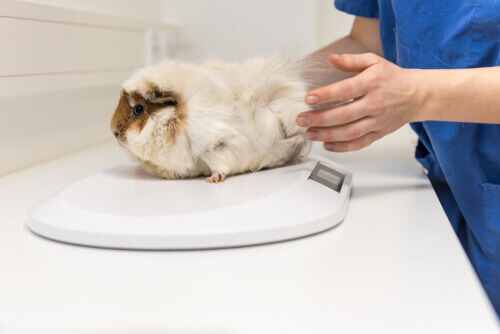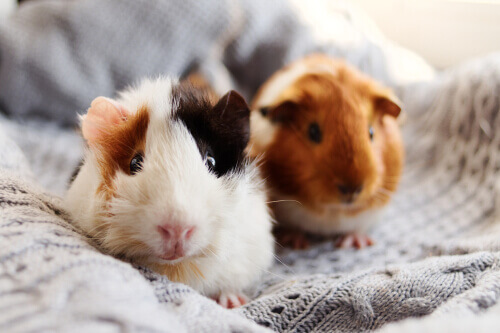How to Treat Tumors in Your Rodents


Written and verified by the biologist Ana Díaz Maqueda
Vets offer the type of consultation rodents need when they develop tumors or become ill in any other way. The need for more clinics specialized in exotic animals has arisen as many people are now keeping them as pets.
Rats, mice, guinea pigs, hamsters, degus, and gerbils should consult a vet regularly (just like dogs and cats) even if they’re not sick. You should plan a visit particularly when they get older as this is a factor that significantly increases the probability of them having tumors.
Like other animals, rodents also develop pathologies. The difference is that their metabolism is faster and so is the development of a disease. Unfortunately, the animal would die in a matter of days.
There are accounts of hamsters dying suddenly even though their owners noticed no symptoms of a disease the day before.
When you keep a rodent as a pet, you must be extremely attentive to any change in their routine. For instance, are they eating more or less? Has their facial expression changed in any way?
Each rodent species requires a specific diet, so take that into account. This is because an imbalanced diet is one of the reasons why this kind of animal gets sick. Digestive problems, along with tumors, are the most common diseases among pet rodents.

Types of tumors in rodents
Tumors are one of the most common pathologies of these kinds of animals when they reach old age. Also, life expectancy varies greatly between the many species, as does the appearance of spontaneous tumors. These are the life expectancies of the various domestic rodents:
- Rats can live between two and three and a half years
- Mice only live between one and two and a half years
- Gerbils get to live about two to three years
- Hamsters can live between a year and a half and two years
- Guinea pigs from four to eight years old
- Degus have a longer life expectancy, they can live to about 10 years of age
Likewise, the frequency with which tumors appear in rodents also depends on the species.
For example, rats develop neoplasms more often than mice or, in general, more than other pets.
The most commonly observed types of tumors
- Rats develop benign breast fibroadenomas, skin fibromas, and fibrosarcomas, lymphosarcomas, uterine carcinomas, and benign thymic tumors. They appear when the animal is approximately two years old.
- In mice, the so-called cancerous age begins in the second half of their first year of life, and usually at the age of 16 months — this is when the highest peak occurs. Tumors appear in up to 10% of mice by the age of two, and breast adenocarcinomas are the most common.
- Gerbils develop squamous cell carcinomas, melanomas, and neoplasms of the female reproductive system.
- Hamsters usually develop nodal lymphosarcomas, adrenal cortical tumors, and uterine adenocarcinomas. Tumors may rarely appear on their cheeks and these are related to the cheek pouch.
- Guinea pigs may develop trichofolliculomas. These are benign tumors typically located in the dorsal-lumbar region with alopecia and scab with an open central pore that can suppurate. They can also suffer neoplasms of the lungs, reproductive tract, mammary glands, and hematopoietic system.
- Common Degu often develop hepatocellular carcinomas

Is there a cure?
The main thing to keep in mind is the vast majority of tumors in rodents originate when the animal has reached an advanced age. So, putting your pet down may be the most ethical option for a pet with a malignant tumor — your vet will recommend it if this is the case.
However, these tumors are usually benign and don’t pose a danger to the life of an animal. They might be a nuisance to them though, especially if they grow too much and keep them from moving as usual.
In conclusion, a vet might be able to remove a tumor if it doesn’t pose a risk to the rodent.
Vets offer the type of consultation rodents need when they develop tumors or become ill in any other way. The need for more clinics specialized in exotic animals has arisen as many people are now keeping them as pets.
Rats, mice, guinea pigs, hamsters, degus, and gerbils should consult a vet regularly (just like dogs and cats) even if they’re not sick. You should plan a visit particularly when they get older as this is a factor that significantly increases the probability of them having tumors.
Like other animals, rodents also develop pathologies. The difference is that their metabolism is faster and so is the development of a disease. Unfortunately, the animal would die in a matter of days.
There are accounts of hamsters dying suddenly even though their owners noticed no symptoms of a disease the day before.
When you keep a rodent as a pet, you must be extremely attentive to any change in their routine. For instance, are they eating more or less? Has their facial expression changed in any way?
Each rodent species requires a specific diet, so take that into account. This is because an imbalanced diet is one of the reasons why this kind of animal gets sick. Digestive problems, along with tumors, are the most common diseases among pet rodents.

Types of tumors in rodents
Tumors are one of the most common pathologies of these kinds of animals when they reach old age. Also, life expectancy varies greatly between the many species, as does the appearance of spontaneous tumors. These are the life expectancies of the various domestic rodents:
- Rats can live between two and three and a half years
- Mice only live between one and two and a half years
- Gerbils get to live about two to three years
- Hamsters can live between a year and a half and two years
- Guinea pigs from four to eight years old
- Degus have a longer life expectancy, they can live to about 10 years of age
Likewise, the frequency with which tumors appear in rodents also depends on the species.
For example, rats develop neoplasms more often than mice or, in general, more than other pets.
The most commonly observed types of tumors
- Rats develop benign breast fibroadenomas, skin fibromas, and fibrosarcomas, lymphosarcomas, uterine carcinomas, and benign thymic tumors. They appear when the animal is approximately two years old.
- In mice, the so-called cancerous age begins in the second half of their first year of life, and usually at the age of 16 months — this is when the highest peak occurs. Tumors appear in up to 10% of mice by the age of two, and breast adenocarcinomas are the most common.
- Gerbils develop squamous cell carcinomas, melanomas, and neoplasms of the female reproductive system.
- Hamsters usually develop nodal lymphosarcomas, adrenal cortical tumors, and uterine adenocarcinomas. Tumors may rarely appear on their cheeks and these are related to the cheek pouch.
- Guinea pigs may develop trichofolliculomas. These are benign tumors typically located in the dorsal-lumbar region with alopecia and scab with an open central pore that can suppurate. They can also suffer neoplasms of the lungs, reproductive tract, mammary glands, and hematopoietic system.
- Common Degu often develop hepatocellular carcinomas

Is there a cure?
The main thing to keep in mind is the vast majority of tumors in rodents originate when the animal has reached an advanced age. So, putting your pet down may be the most ethical option for a pet with a malignant tumor — your vet will recommend it if this is the case.
However, these tumors are usually benign and don’t pose a danger to the life of an animal. They might be a nuisance to them though, especially if they grow too much and keep them from moving as usual.
In conclusion, a vet might be able to remove a tumor if it doesn’t pose a risk to the rodent.
All cited sources were thoroughly reviewed by our team to ensure their quality, reliability, currency, and validity. The bibliography of this article was considered reliable and of academic or scientific accuracy.
- Brown, C., & Donnelly, T. M. (2012). Disease problems of small rodents. Ferrets, rabbits, and rodents, 354.
- Collins, B. R. (2008). Endocrine diseases of rodents. Veterinary Clinics of North America: Exotic Animal Practice, 11(1), 153-162.
- Daviau, J. (1999). Clinical evaluation of rodents. Veterinary clinics of North America: Exotic animal practice, 2(2), 429-445.
- McLaughlin, A., & Strunk, A. (2016). Common emergencies in small rodents, hedgehogs, and sugar gliders. Vet Clin North Am Exot Anim Pract, 19(2), 465-499.
- POPJRISTOVA, E., POPOV, E., & REQUEJO, C. C. (2019). Tumores espontáneos en roedores de laboratorio. Revista Cubana de Medicina, 11(5-6).
This text is provided for informational purposes only and does not replace consultation with a professional. If in doubt, consult your specialist.








